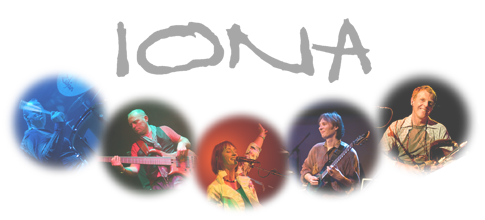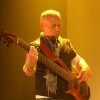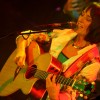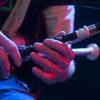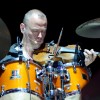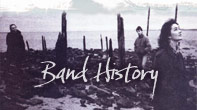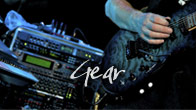Dave's Gear
**This interview from c2002 has been updated with additional information through June 2011, highlighted in yellow.Dave Bainbridge took time out from family, music and generally running all things IONA to talk about his guitars, keyboards, effects and the IONA sound.
Strict Standards: Non-static method Photos::getPhotoUrl() should not be called statically, assuming $this from incompatible context in /var/www/iona/application/views/scripts/common/photo-single.phtml on line 6
Dave Bainbridge: Guitars / Keyboards / Bouzouki / Programming
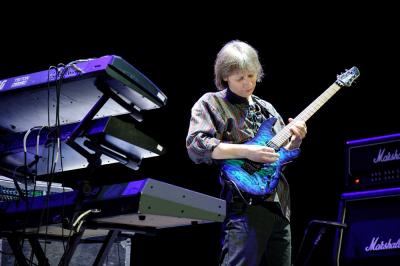
Q. What are the main changes to your 'sound' now compared with the band's first gigs?
 Over the first year or two of IONA's existance, the band was basically myself (keyboards and guitars),
Joanne (vocals, keyboard and acoustic guitar) and David Fitzgerald (saxophones, flutes, whistles,
tenor recorder etc). When we could afford to, we had guest musicians play with us, but on many of
the early gigs we had to rely on electronically generated drums and bass, or, if we could afford to
pay a drummer, then just sequenced, synthesised bass parts which the drummer played along to.
This worked quite well and gave us a lot of flexability regarding where we could play, but we didn't have
the dynamics or sponteneity that the full band line-up could generate. Once we were able to
regularly incorporate Frank (then later Terl) on drums and Nick Beggs on Chapman Stick & Bass, then
the full IONA 'live' sound became more established.
Over the first year or two of IONA's existance, the band was basically myself (keyboards and guitars),
Joanne (vocals, keyboard and acoustic guitar) and David Fitzgerald (saxophones, flutes, whistles,
tenor recorder etc). When we could afford to, we had guest musicians play with us, but on many of
the early gigs we had to rely on electronically generated drums and bass, or, if we could afford to
pay a drummer, then just sequenced, synthesised bass parts which the drummer played along to.
This worked quite well and gave us a lot of flexability regarding where we could play, but we didn't have
the dynamics or sponteneity that the full band line-up could generate. Once we were able to
regularly incorporate Frank (then later Terl) on drums and Nick Beggs on Chapman Stick & Bass, then
the full IONA 'live' sound became more established. 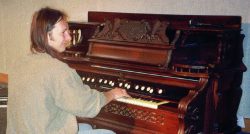 As regards my set
up personally, certainly many of the keyboard / textural sounds have become more refined and
interesting as technology has moved on. For the
first couple of years much of my live keyboard rig was hired or borrowed (mainly from Adrian Snell
with whom I was working a lot with at the time and Dave Cass - a great guy who I'd known since music
collegs days in Leeds - who ran a keyboard hire business). There are still a couple of bits of gear
which I've used since the late '80's, which have sounds which I still love and which are very much
associated with the 'IONA sound' - these are a Roland JX10 synth and a Korg M1R module. The
combination of these two can be heard on the opening section of the very first track on the first
album 'IONA' and on pieces like 'Luke' from 'The Book of Kells'.
As regards my set
up personally, certainly many of the keyboard / textural sounds have become more refined and
interesting as technology has moved on. For the
first couple of years much of my live keyboard rig was hired or borrowed (mainly from Adrian Snell
with whom I was working a lot with at the time and Dave Cass - a great guy who I'd known since music
collegs days in Leeds - who ran a keyboard hire business). There are still a couple of bits of gear
which I've used since the late '80's, which have sounds which I still love and which are very much
associated with the 'IONA sound' - these are a Roland JX10 synth and a Korg M1R module. The
combination of these two can be heard on the opening section of the very first track on the first
album 'IONA' and on pieces like 'Luke' from 'The Book of Kells'.
Keyboards: 'Another Realm' sessions, 2011
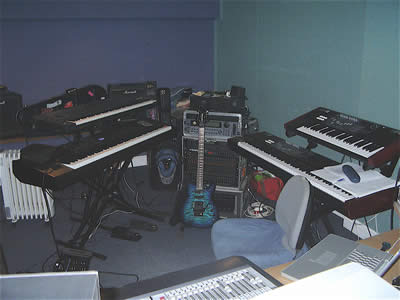
I'm still using my 1986 vintage Roland JX10 (middle keyboard in the 1989 pic) live with the band,
mainly as a master keyboard to control sounds from a Roland XV5080 synth module! On the new album
'Another Realm' I wanted to come up with some new sound textures, so I went back to some of my old
gear that I hadn't used much for a while but processed the sounds through various modern plug in fx
on my MacBook Pro and got some very interesting results! So, on 'Another Realm' you can hear, if you
listen closely, sounds from my 1982 Sequential Circuits Pro one synth (used this on the track
'Saviour'), the aforementioned Roland JX10 ('on As It Was', As it Shall Be' and 'An Atmosphere on
Miracles') and Korg M1R (on 'Let Your Glory Fall'), Yamaha TX816 FM Synth (see 1989 pic - used on
'Let Your Glory Fall' and 'An Atmosphere on Miracles') and my 1985 Oberheim Matrix 1000 rack synth!
More modern hardware synths were also used - Joanne's Yamaha S90XS is on a lot of tracks and my 10
year old Roland XV5080.

In February 2007 I finally retired my 1989 Atari Mega 2 computer and Cubase 2.0 and took the plunge and started using a Digital Audio Workstation (DAW) called Digital Performer on an iMac. Since then Digital Performer has been my main recording / sequencing medium and I've really got into the world of plug in synths. I used Sampletank from IK Multimedia probably on every track on 'Another Realm'! I have most of their sound libraries loaded into it (Cinematik, World & Ethnic Collections, Samplemoog, Sampletron and Sonic Synth 2). When I demoed tracks for the band I used some sounds from Sampletank as they were nearest thing I could find to the sound of Frank and Phil playing! I also used a great software sampler called Mach 5 from Motu for which I have various sound libraries and also Ethno Instrument from Motu which has some reasonable uilleann pipes and low whistle samples which are useful for demoing IONA tracks before we record the real thing!
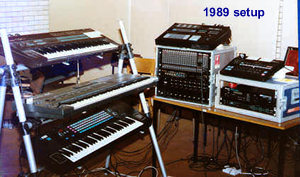
1989 SETUP:
KEYBOARDS (top to bottom) Yamaha DX7 Roland JX10 Sequential Circuits Pro phet 2000 (sampler) (out of shot to left; Sequential Circuits Pro One mono synth) RACK - LEFT (top to bottom) Yamaha QX1 Sequencer Roland M160 Mixer Roland DEP 5 Multi FX Yamaha TX816 (8x DX7's) RACK - RIGHT (top to bottom) Yamaha RX11 (drum machine) Roland MKS20 (piano module) Yamaha SPX 90 (Multi FX)On the guitar side, when we started the band I had two electric guitars, the main one being a Yamaha SG700 - which was my first serious guitar. It has a nice thick Les Paul kind of sound, but also coil taps to allow thinner tones to be produced as well. I used that on things like 'Flight of the Wild Goose' and 'Trilogy' from the first album. The other guitar was a '70's Fender Stratocaster (pictured below), which my sister bought me as a present in 1982 for £210 from a second hand guitar shop in Leeds!
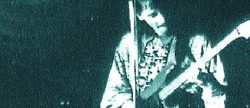 Amplication was fairly rudimentary - a 50 watt Marshall combo - a great sound but not very
flexible for what I wanted to do - a bit rock 'n roll! A big step forward was in 1991 when I was
able to afford a stereo Marshall rackmounted set up and incorporate more effects, and begin to
explore more interesting textural, atmospheric sounds.
Amplication was fairly rudimentary - a 50 watt Marshall combo - a great sound but not very
flexible for what I wanted to do - a bit rock 'n roll! A big step forward was in 1991 when I was
able to afford a stereo Marshall rackmounted set up and incorporate more effects, and begin to
explore more interesting textural, atmospheric sounds.  In 1993, the acquisition of a delay
unit by a company called Bel electronics became a key feature of my sound. This has a delay time of
over 26 seconds, and loop, reverse and half speed modes (rare at the time) - and gave me the ability
to build up great rhythmic and atmospheric textures. You can hear this in use on the Heaven's Bright
Sun live album on tracks like IONA (atmospheric loops behind Troy's Ebow slide guitar) and on 'When
I Survey' (big rhythmic build up).
In 1993, the acquisition of a delay
unit by a company called Bel electronics became a key feature of my sound. This has a delay time of
over 26 seconds, and loop, reverse and half speed modes (rare at the time) - and gave me the ability
to build up great rhythmic and atmospheric textures. You can hear this in use on the Heaven's Bright
Sun live album on tracks like IONA (atmospheric loops behind Troy's Ebow slide guitar) and on 'When
I Survey' (big rhythmic build up). I retired the Bel to studio use only in 1999 as it was a bit temperamental - replacing it with a Lexicon MPXG2 pre-amp fx processor which does a similar thing, but has lots more creative possibilities.
Since 2005 I've also used a Boss Loopstation pedal which is a great looper with 15 minutes of memory. Troy (Donockley) and I got one each at the same time and you can hear them both being used a lot on 'The Circling Hour' album. On the track 'Skymaps' Troy created some acoustic guitar and vocal loops with it. I've just lent mine to Phil as he's keen to explore looping possibilities on the bass!
Q. You use quite an array of effects pedals; can you tell us a bit more about what they deliver (i.e. the Bainbridge electric guitar sound) without giving away too much!?
Early in 1999, after much research, I changed completely my electric guitar set up. My search for more varied and creative sound textures led me to the Roland VG8 (pictured below) - an amazing box which originally came out around 1995.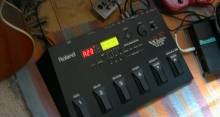 With a special pick up added to one's guitar it can produce an amazing variety of sounds - from
pseudo acoustic to synth pads to all manner of guitar and amp combinations. It was the first box to
be able to imitate the sound of different guitars / amps / pick ups / stomp boxes etc. At the press
of a button you can change from a clean strat through a Fender amp to a Les Paul on 11 through a
Marshall stack!
With a special pick up added to one's guitar it can produce an amazing variety of sounds - from
pseudo acoustic to synth pads to all manner of guitar and amp combinations. It was the first box to
be able to imitate the sound of different guitars / amps / pick ups / stomp boxes etc. At the press
of a button you can change from a clean strat through a Fender amp to a Les Paul on 11 through a
Marshall stack! Another great feature, which I use a lot, is the ability to actually store different tunings for each patch. You can hear this on the track 'Open Sky' - where I use a 'pseudo sitar' type sound from the VG8 in a sort of 'E' open tuning. The pitch bending is done with a foot pedal - you can assign different tunings depending on whether the pedal is up or down! In fact the bass on section 3 of 'Songs of Ascent' on the 'Open Sky' album was played by me on guitar using a bass guitar patch on the VG8 (we'd changed the arrangement and Phil wasn't in the studio at the time!).
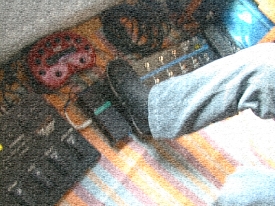 One of the less comprehensive features of the VG8 is the fx section, so I run the
VG through the aforemention Lexicon MPXG2 to give me more flexability - great reverbs / loop delay
up to 20 seconds etc. The large pedalboard I use is a Lexicon MPX R1 (pictured right) - which is the
remote controller for the MPXG2 (which is rackmounted .. you can see the big rack below!).
One of the less comprehensive features of the VG8 is the fx section, so I run the
VG through the aforemention Lexicon MPXG2 to give me more flexability - great reverbs / loop delay
up to 20 seconds etc. The large pedalboard I use is a Lexicon MPX R1 (pictured right) - which is the
remote controller for the MPXG2 (which is rackmounted .. you can see the big rack below!). This is great for instant changes to my sound. I also have a couple of other pedals - a volume pedal for the Lexicon and an expression pedal for the Roland (which can be assigned to do just about anything - volume / tuning changes / clean sound to overdriven sound etc).
 This set up allowed me to ditch using a conventional guitar amp / speaker set up on stage
- so now the guitar signal goes directly to the pa system and I monitor it on stage through a pair
of full range small PA speakers, which I also use to monitor my keyboard sounds.
This set up allowed me to ditch using a conventional guitar amp / speaker set up on stage
- so now the guitar signal goes directly to the pa system and I monitor it on stage through a pair
of full range small PA speakers, which I also use to monitor my keyboard sounds. My acoustic guitar and bouzouki also go through the same set up, so I know I'm going to get a consistant sound from gig to gig. More recently I've also been using a Line 6 Pod - another great little amp / speaker 'modelling' fx box, but only for studio use at the moment.
When I recorded my solo album 'Veil of Gossamer' in 2003/4 I used the above set up plus some of the built in amp models on my Roland VS2480 digital recording studio. There was one in particular - a model of a Soldano amp that I tweaked a bit and really liked. That was the sound for the solos on 'Over the Waters' and 'The Homeward Race'. I used my Marshall amp for the solo on 'Everlasting hills Part 1' but that was the only track I used an actual amp on. At the time my studio was a spare bedroom and we had two small children, so it wasn't practical to have amps turned up to 11 in there!
Although the VG8ex/Lexicon MPX G2 set up was great I happened to be in a guitar shop in London in late 2005 and they had a small Cornford valve combo amp in. I was actually there with a friend who was interested in a guitar. I tried said guitar through this amp and was blown away - not by the guitar - but by the amp! The responsiveness and beautiful, smooth overdriven sound was wonderful. A short while later I contacted Paul Cornford who designed and built the amp (his company are based in the south east of England) and managed to get a Cornford Hurricane amp just in time for doing the guitar parts on Iona's 'The Circling Hour' album in January 2006. I used it for most of the lead parts on that album. It's a great amp - only 18 watts and one channel - but has a lovely warmth to the sound. I'm still using that amp in the studio and live - except in the USA where they're difficult to get hold of from hire companies - in conjunction with the VG/Lexicon set up. I use a Boss LS2 Line Selector pedal so I can either just have the sound of the amp, or the amp plus the VG and Lexicon, or just the VG/Lexicon. It's a very flexible set up. Ideally I'd love a 2 or 3 channel Cornford amp for even more flexibility live but can't afford that option at the moment!
The other major development since we recorded 'The Circling Hour' is that I've been using an amazing guitar amp/speaker/fx simulator plug in called Amplitube from IK Multimedia which I run on my MacBook Pro. I first had Amplitube 2, and really liked it but they really raised the bar with Amplitube 3. The quality of the sounds and responsiveness is amazing. On 'Another Realm' I used it on most tracks, quite often recording simultaneously through Amplitube and the Cornford amp. A lot of the lead and overdriven rhythm sounds are a mix of the two, though I still used the VG8 and Lexicon for some sounds. Amplitube is also great for unusual, radical effects - the opening of 'White Horse' for example has a sound like a horse screaming at the beginning which I created on there. In another place on 'White Horse' I used a reverse echo effect from Amplitube. I'd love to be able to use the Amplitube sounds live at some point but would need a dedicated pedalboard and another computer to really make it feasible - so that may be a little way down the road just yet.
Another pedal I added in 2009 to my pedalboard is a Catalinbread Super Chili Picoso clean boost pedal. This is a brilliant little box which allows me to back off the gain on my amp and switch the pedal in for lead sounds - in effect converting my single channel Cornford amp into a 2 channel amp. It has a 'fat' switch which does exactly that - fatten up the sound in a nice way. When recording di'ed guitar parts (clean or through Amplitube) I now always run the guitar through this, with the level set to zero. It acts as a buffer and really retains all the guitars hi end sparkle - it's amazing the difference it makes. About the same time I brought my 1980 vintage Boss DS1 Distortion pedal out of retirement and that's now a permanent fixture on my pedalboard. With the tone and distortion pots set to zero it just adds a nice creaminess when I want a more sustained lead sound - especially for legato style playing. I Also used Phil's old Cry Baby Wah Wah pedal on the solo on 'White Horse' and would love to incorporate a wah-wah live but this particular one has seen better days - the bypass setting makes everything sound dull - so something else there for the shopping list!
Q. Can you tell us a bit about the Fernandes guitar you now use as seen on the recent gig's photos. Is the Ibanez redundant?
One of the reasons I wanted to go for a set up that I could use without a noisy guitar amp was so that I could record electric guitar at home without blasting out the neighbours - and more importantly my wife and children! My studio room is basically the spare bedroom (although there are plans to move out into a soundproofed outbuilding in the near future).My Open Sky Studio was built in 2004 and is totally soundproofed and has a small booth in which amps can really be cranked up without fear of environmental health officers invading!
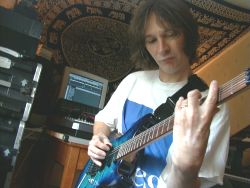 Whilst the VG/Lexicon set up behaved pretty much like a standard amp / speaker
set up on gigs, ie it was loud enough for me to get controlled sustain and feedback by virtue of
standing near the speakers, at home at low volume, the sustain element was lacking.
Whilst the VG/Lexicon set up behaved pretty much like a standard amp / speaker
set up on gigs, ie it was loud enough for me to get controlled sustain and feedback by virtue of
standing near the speakers, at home at low volume, the sustain element was lacking. 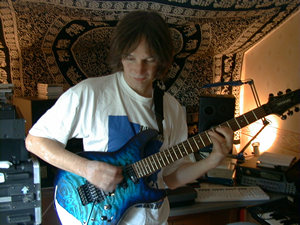 However, I'd read a magazine article with David Bowie's guitarist Reeves Gabrels about his use of
the Roland VG8, in which he explained how he got around the same problem of lack of sustain by using
his 'Fernandes sustainer'. It didn't explain in the article what a 'Fernandes sustainer' was - I
assumed it was some kind of pedal. Anyway after some research, I discovered Fernandes Guitars and
read about their patented 'sustainer' pick up system.
However, I'd read a magazine article with David Bowie's guitarist Reeves Gabrels about his use of
the Roland VG8, in which he explained how he got around the same problem of lack of sustain by using
his 'Fernandes sustainer'. It didn't explain in the article what a 'Fernandes sustainer' was - I
assumed it was some kind of pedal. Anyway after some research, I discovered Fernandes Guitars and
read about their patented 'sustainer' pick up system. Basically their sustainer guitars have a switch which turns on the sustainer pick up, and a magnetic current makes the guitar strings vibrate in the same way that they do with acoustic feedback - the result being infinate sustain - the guitarist's holy grail! On top of that, they have another switch with which you can choose which harmonic of the note you're playing will sustain - it can be the fundamental (the note itself), or an octave higher, or and octave and a fifth higher.
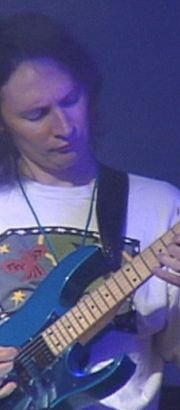 Anyway, after tracking down the UK
distributors, I was able to try a couple of different models and was very impressed and bought a
'Dragonfly Elite' model, which I then had customised to include a built in Roland GK2a synth pickup
and controls to operate the VG8.
Anyway, after tracking down the UK
distributors, I was able to try a couple of different models and was very impressed and bought a
'Dragonfly Elite' model, which I then had customised to include a built in Roland GK2a synth pickup
and controls to operate the VG8. (NB; This job was expertly carried out by Barrie Palmer at Machine Head. For those guitar affectionados amongst you, there are some close up pictures of Dave's Fernandes guitar at Machine head's web site; www.machinehead.co.uk - look in the 'Workshop' section).
The Fernandes is great for long sustained lead lines such as in the track 'Woven Cord'. You can hear the sustainer working to great effect on the atmospheric feedback effects on the reworked version of 'The Island' on the box set.
The interesting looping texture that opens and closes the track 'IONA' (again on the box set version) was all done on the Fernandes - using the sustainer effect and sounds from the VG8, looped and processed on the Lexicon.
The blue Ibanez guitar (pictured right) - which has served for many years has taken a bit of a back seat, but I'll certainly be using it a lot on recording - it's great for the brighter more crystalline clear sounds.
I did indeed use the old Ibanez guitar on several tracks on 'Another Realm'. Than and the Fernandes were the only two electric guitars used on the whole album.
Q. IONA is characterised by multi-layered synth & keyboard soundscapes. How has this evolved from the early days? What keyboards are used on stage by you & Jo?
 In a sense, what is most important is the concept behind the sounds. From the
beginning with IONA I've had a very clear idea of what kind of role the keyboard / synth sounds
should play, what emotions and feelings they should conjure up. That has been key to creating the
soundscapes from which Jo's voice and the lead instruments can find inspiration - a case of finding
the right foil to make the solo elements shine. A good analogy is the way the stars shine at their
brightest in the night sky on the clearest, darkest, least obtrusive background. That's certainly
the effect that I hope to achieve with tracks like 'Friendship's Door', 'The Search' and 'Luke'.
In a sense, what is most important is the concept behind the sounds. From the
beginning with IONA I've had a very clear idea of what kind of role the keyboard / synth sounds
should play, what emotions and feelings they should conjure up. That has been key to creating the
soundscapes from which Jo's voice and the lead instruments can find inspiration - a case of finding
the right foil to make the solo elements shine. A good analogy is the way the stars shine at their
brightest in the night sky on the clearest, darkest, least obtrusive background. That's certainly
the effect that I hope to achieve with tracks like 'Friendship's Door', 'The Search' and 'Luke'. Another is a sense of place, not linked to any particular time - but perhaps a yearning to be closer to God's creation, to evoke the presence of some of the vast, lonely landscapes that have, at various times in my life, made such a big impression on me, and in which the distractions of modern life give way to a purer, clearer communion between man and the eternal.
Another approach is to make the electronic sounds as 'organic' and human as possible, so that they blend with their acoustic counterparts. In a way talking about specific keyboards and guitars is like a sculpter talking about what make of hammers and chisels he uses! At the end of the day they're only tools and what is far more important is the finished work of art. Having said that, it obviously helps to have the best possible tools to achieve that end product!
So, talking more specifically, until recently, my live rack consisted of several synth modules; Korg M1R / EMU E-Synth sampler / Oberheim Matrix 1000 / Roland JV1080 / Roland R8M (with numerous expansion cards) all through a Roland M120E mixer, but I have recently (primarily to cut down on soaring excess baggage charges at airports!) replaced all these with a Roland XV5080. The XV5080 is a superb box, and with the 128 megs of sample ram which I have installed, I am able to access all the necessary samples needed for the IONA set.
I may also have the JV1080 with me for UK dates. I've always been a big fan of Roland gear and the programming possibilities on modules such as the 1080 and 5080 are huge. I tend to do a lot of programming my own sounds and am grateful for having had the opportunity, when at Leeds College of Music, to learn a lot about sound design, especially on synthesisers.
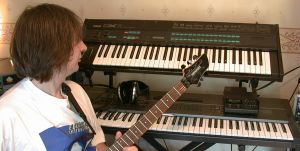 Keyboard-wise, since most of the sounds I use are generated from the
modules, I'm not tied to using any specific models (as long as they have MIDI !). This makes things
more flexible when touring abroad, where we usually have to hire in the keyboards. When a preference
is available, I go for two Roland XP80's or an XP80 and a Korg M1 - mainly because I have sounds I
can instantly load into them. At home, I still use my Roland JX10 a lot - there are some great
atmospheric sounds to be had out of that, particularly when creatively combined with outboard reverb
/ delay etc effects. You can hear that on a few of the 'Snowdonia' tracks on the box set - eg
'Dunes' and 'Above the Clouds'.
Keyboard-wise, since most of the sounds I use are generated from the
modules, I'm not tied to using any specific models (as long as they have MIDI !). This makes things
more flexible when touring abroad, where we usually have to hire in the keyboards. When a preference
is available, I go for two Roland XP80's or an XP80 and a Korg M1 - mainly because I have sounds I
can instantly load into them. At home, I still use my Roland JX10 a lot - there are some great
atmospheric sounds to be had out of that, particularly when creatively combined with outboard reverb
/ delay etc effects. You can hear that on a few of the 'Snowdonia' tracks on the box set - eg
'Dunes' and 'Above the Clouds'. Joanne has has a Roland XP80 for several years now - it's a good workhorse synth. She's not at all interested in programming sounds, which is fine, so I do that side of things for her!
A sampler has always been a significant instrument for me and being able to sample and layer my own samples (eg of Jo's voice / Frank's violin / my guitars) has broadened the IONA soundworld.
My current live keyboard set up consists of 3 keyboards:
Roland XP80 - Jo's old one (with the Orchestral expansion card), which has some key Iona sounds. If we're abroad and they don't have one I can substitute another keyboard and use a Roland JV1080 rack module - which has all the same sounds.
Roland JX10 - used as a master keyboard to play sounds from my Roland XV5080 rack module. The XV has several Expansion cards inside it. Occasionally I will also use the internal sounds from the JX10 live.
CME UF8 - This is an 88 note, weighted master keyboard which I use live to play sounds from plug in synths on my MacBook Pro from Sampletank and Mach 5. The way I have the midi routed from the computer I can also play sounds from the XV5080 on here.
Rack - this contains: Roland XV5080, Roland JV1080, Roland M12E rack mixer, Motu Traveler (audio interface for the computer) and Lexicon MPX G2 guitar pre-amp/fx
MacBook Pro running Digital Performer, using Sampletank and Mach 5 plug in synths.
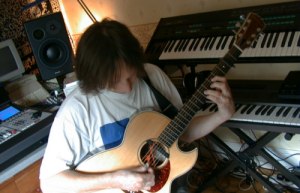
Q. Do you have a chosen instrument - a kind of 'desert island disc' choice?
It would either have to be an acoustic guitar (my Manson or Fylde Oberon), or a nice grand piano (but that would have to come with a piano tuner!). Much of the inital inspiration for pieces comes from playing a realy nice acoustic instrument - ideas that can then be translated into a bigger soundscape.Q. Do you and Troy go for a similar acoustic guitar ambience, in other words, do you settle on a similar sound or are they different? A bit of info on the acoustic guitars would be good here.
We are both primarily fingerstyle players when it comes to acoustic guitars. A few months ago we recorded a whole load of improvisations / ideas with just the two of us playing acoustic guitars. It was great fun and listening back I can clearly hear our two distinct styles. I'm not sure how I'd describe the differences exactly. We both have a Fylde Oberon small bodied acoustic so we obviously go for similar sounds.Some of these improvisations ended up as material we used on 'The Circling Hour' - in particular for the track Strength.
The Fyldes have tremendous sustain and a lovely brightness and clarity to them. The Manson Magpie acoustic I have is nice in that it has a cutaway, so I'm able to access the higher frets. It really sings in the upper registers. There are some differences in the tunings we use. I know Troy likes to play in an open G tuning (DGDGBG I think), whereas I love tunings like CGDGAD or CGCGCD or DAGAD. I also use a metal thumb pick, whereas Troy just has a very long thumbnail!
On 'Another Realm' I played all the acoustic guitar parts using the Fylde Oberon and Manson Magpie using various tuning and capo positions. On a few tracks I had the Manson strung with a set of Nashville strings (courtesy of SIT Strings) which has several strings an octave higher than normal. This is great for sparkly rhythm parts or high, almost dulcimer sounding picking parts - especially when used with a capo.
Q. What was involved in recording the new parts for the box set - how was this achieved in the studio? .. maybe expand this Dave if you want to explain the recording/mixing equipment
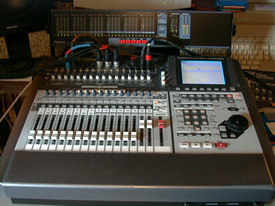 The re-working and remixing of tracks on cds 1 and 4 of the box set
coincided with my investment in a new recording set up, based around a Roland VS2480 Digital
Workstation (pictured).
The re-working and remixing of tracks on cds 1 and 4 of the box set
coincided with my investment in a new recording set up, based around a Roland VS2480 Digital
Workstation (pictured). The new set up made it possible to do all the work on the box set (apart from the 'live in the studio' tracks on cd4) in my home studio. It took quite a while to do, not least because, as with any new piece of gear, you have to get to know it quite well before you can get the best out of it. Some of the trials and tribulations are documented in the introduction that I wrote for the box set booklet.
Basically, we had to keep the recording costs down as low as we could without sacrificing any quality. I also didn't want to completely re-record everything as there was no real need and I didn't want to loose the essence of what had originally been achieved, so I concentrated on doing what I could in my small room. Once I had all the original multitrack tapes transferred to the VS2480, it was a case of seeing what was there, correcting some of the obvious deficiencies, and then seeing what could be added / replaced to make the music better and bring some of the sounds more up to date. I made a conscious decision, when working on the first album (IONA) not to replace any of the original main solos, lead lines or vocals. I did add a solo where previously there wasn't one, however, on 'A Machair' and found a few alternate sax / vocal takes from the original multitracks which I used bits from.
I also corrected the tuning in a few places on the vocals with a great device called an Antares Autotune. I have to say though, that the first album was Jo's first major studio work and even though she was understandably a little nervous at the time (and I was less experienced as a producer) and as a result a few vocal imperfections crept through, listening afresh I was amazed at how good she sounded.
So, there are a lot of new textural and rhythmic sounds, with some arrangements only slightly changed, whilst other tracks like 'A Machair', 'Vision of Naran' and 'Turning Tide' have been considerably updated! All the new parts, with the exception of a drum loop that Frank had recorded which I used on 'A Machair' were played by Troy and I. It was great to feature Troy more on the 'IONA' album - his backing vocals on 'The Island' and 'Dancing on the Wall' in particular really work well with Jo's voice and I love the additional low whistle on the title track 'IONA'. The opportunity for me to play bouzouki on a few tracks (and Troy on Moondawn on cd4) was great too, as that instrument has become a significant part of IONA's sound, yet I didn't have one back in 1989! There are also several places where I added layered samples (from the many I have in my sound library!) of Jo's voice - another aspect that I feel really enhances the atmosphere of the songs on the 'IONA' album. I feel that the pieces on the 'IONA' album now flow together much better than they did originally.
I still have the VS2480 but use it mainly now as a mixer for monitoring tracks when I'm recording onto my MacBook Pro.
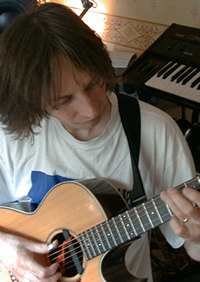
Q. Of all the gear you have, is there any one item that would constitute a disaster if it was lost? In other words, what do you value most.
A. All the bits of gear I have are valuable in their own right in terms of creating the 'soundworld' that I inhabit. I don't think there's any particular one that I can think of....except maybe all the floppy disks, sound cards and jaz disks I have with my samples & sounds on - they'd be impossible to replace. On the other hand, sometimes being in a situation of not having what you most rely upon forces you into new ways of thinking - improvising solutions that otherwise you'd never have discovered. That's happened to me on several occasions, when bits of gear have broken down, or I've forgotten to take something vital along to a gig.My key piece of gear since 2008 has to be the MacBook Pro - it's really revolutionised the way I work. During the recording of 'Another Realm' it was amazing being able to go over to Jo's or to Frank's on the plane and basically just take that and a small audio interface in my rucksack - and that was the studio, whole album and all my sounds right there! I do have everything backed up to external drives though in case it was stolen or broke down.
Q. in 5-10 years time, how much do you think the technology will change, and what is that likely to be? do you think IONA's sound will change significantly in that time?
Technology is changing ridiculously fast as everyone knows, but the trap that many people fall into is that they fall for all the advertising blurb - you know the kind of thing - this computer is 10x faster than the previous one, with 10x as much memory to run all your studio from etc, etc. The equipment is now so complex and with so many features that people end up having to learn how to operate a new piece of gear before they've really mastered the previous one, and as a result only scratch the surface of what the technology is capable of. All this can come in the way of the creative process of actually making music. I know there will be new things I'll
certainly want to buy over the next five to ten years, but I'd hope that I'll still be finding new
sounds on the gear that I've already got and new and creative ways of working with it. I make a
conscious effort to keep up with technological advances in the field of music and do a lot of
research before commiting to buy something so I know that what I get will be a useful piece of
equipment for years to come. Along with the Roland VS2480 I'm still using a 1989 vintage Atari Mega
2 computer for sequencing duties! It rarely crashes, has good timing and I know Cubase on it so well
that I don't have to spend any time trawling through manuals! Other vintage bits of gear that still
inspire new sounds (particularly when combined with more modern effects) include the aforementioned
Roland JX10 keyboard (c1987), a Yamaha DX7 / TX816 combination (c1984) and a Sequential Circuits Pro
One monosynth (c1982). When I finally move into a larger room, I intend to set up the Rhodes piano I
bought new (out of my student grant!) in 1979!
I know there will be new things I'll
certainly want to buy over the next five to ten years, but I'd hope that I'll still be finding new
sounds on the gear that I've already got and new and creative ways of working with it. I make a
conscious effort to keep up with technological advances in the field of music and do a lot of
research before commiting to buy something so I know that what I get will be a useful piece of
equipment for years to come. Along with the Roland VS2480 I'm still using a 1989 vintage Atari Mega
2 computer for sequencing duties! It rarely crashes, has good timing and I know Cubase on it so well
that I don't have to spend any time trawling through manuals! Other vintage bits of gear that still
inspire new sounds (particularly when combined with more modern effects) include the aforementioned
Roland JX10 keyboard (c1987), a Yamaha DX7 / TX816 combination (c1984) and a Sequential Circuits Pro
One monosynth (c1982). When I finally move into a larger room, I intend to set up the Rhodes piano I
bought new (out of my student grant!) in 1979! How will IONA's sound change in that time? Lots of retro funky Rhodes piano solos! No - I don't think IONA's sound will change significantly. I think the general philosophy behind the creation of the band's sound will remain the same. However, within that there are loads of areas still to explore, experiment with, develop and refine.
I'm really excited about the sonic possibilities for the next studio album. When you bear in mind that it will only be the second IONA studio album with the current line up, you can appreciate that we've only really scratched the surface with the instrument combinations we now have.
I'm pleased that both the Iona studio albums we've recorded since this last interview plus my 'Veil of Gossamer' album and the albums with Troy ('From Silence' and 'When World's Collide') all retain a strong sense of identity. There's still the Iona sound, but we're still coming up with new sounds and fresh ideas each time. I think some of the songs on 'Another Realm' are among the strongest and most focussed we've written, so that gives me hope for the future. I'm looking forward to finishing a second solo album before too long. The main unknown is really the music industry itself. Things have changes so much since we first set out and many people now expect to have their music for free, forgetting that many months, even years go into creating truly innovative music that touches the heart and than musicians and their families need to earn a living from their craft like everyone else. I hope we can continue to be able to make this music for as long as we can. We certainly appreciate those loyal fans who instead of downloading or copying our albums for free continue to buy our albums and invest in us.
Continue to Dave's Bio >
THE END
More Gear Pages:
Strict Standards: Non-static method Band::getResults() should not be called statically, assuming $this from incompatible context in /var/www/iona/application/controllers/GearController.php on line 40
Strict Standards: Non-static method Band::getBandMemberById() should not be called statically, assuming $this from incompatible context in /var/www/iona/application/controllers/GearController.php on line 41
Strict Standards: Non-static method Photos::getPhotoUrl() should not be called statically, assuming $this from incompatible context in /var/www/iona/application/controllers/GearController.php on line 62
Comments (0)

